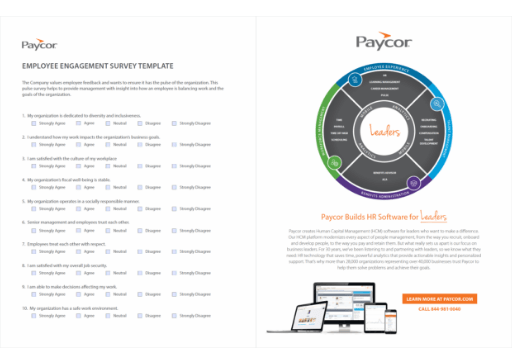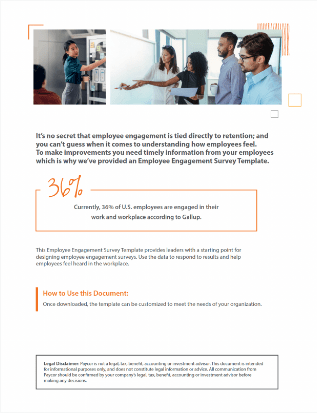One Minute Takeaway
- Employee engagement surveys are conducted to gauge employee sentiment
- Use the feedback from employee engagement surveys to make improvements and retain employees
- Pulse surveys are shorter, more frequent surveys that allow employers to respond faster
With 44% of employees (WTW Survey) looking for a new job, companies are now forced to consider offering higher salaries, better benefits packages, or more flexible work models in order to attract top talent and boost employee retention rates.
Of course, you want to keep employees happy and retain them, but without data, it’s very difficult to make necessary changes. Fortunately, there’s at least one tool that can help: employee engagement surveys. When executed appropriately (not just once per year), you can get specific data about how to enhance your workplace environment and overall employee experience.
What is an Employee Engagement Survey?
Engagement surveys provide employers with insight into the main drivers of employee engagement. The surveys can help identify engagement levels, areas of dissatisfaction or unhappiness and give management the opportunity to address these issues before employees become disgruntled and leave.
What is the purpose of an employee engagement survey?
The purpose of an employee engagement survey is to understand employee sentiment and use the feedback to make improvements on the company culture and people’s experiences at work. You can choose the survey type that makes the most sense for your organizational goals.
- Employee culture and experience surveys contain questions to collect opinions about your employees’ true day-to-day experience and the workplace culture. This could include questions about observed behaviors, patterns and the appropriate or inappropriate nature of others.
- Employee engagement surveys contain questions about an employee’s commitment, motivation and purpose. This survey helps leaders understand how engaged employees are and uses a formula to measure results.
- Employee satisfaction surveys contain work-related questions about policies, compensation, and work hours to determine employee satisfaction levels.
What are the Types of Employee Surveys?
Annual Surveys
Conducting an annual employee engagement survey provide a platform for employees to express their opinions on different matters, which can be helpful when making decisions that directly affect the day-to-day operations of a business.
Pulse Surveys
Pulse surveys are conducted as often as desired by the company, depending on the precision of measuring employee sentiment needed and are usually electronic, shorter, and include questions about workplace culture and engagement. The questions asked in these surveys are typically open-ended, allowing employees to provide more detailed responses.
Employee Lifecycle
Employee lifecycle surveys are targeted towards a specific moment in an employee’s time at the company such as when they start or exit. These surveys capture the employee’s experience of the company and its processes.
Measuring Employee Engagement
When crafting questions, it’s important to consider the overall goals of your survey. Do you want to measure employee satisfaction, employee performance, identify areas that need improvement, or understand the reasons behind a lack of engagement? Knowing what information you are trying to collect can help guide your questions and make sure they provide valuable feedback.
Questions should be framed in a way that allows employees to express their opinion and feelings openly. Try to avoid leading questions, which can bias the responses or limit the results. Aim for open-ended questions that allow your employees to provide detailed employee feedback on their experience while still providing useful information.
How can your business use the results of an employee engagement survey?
Employers should analyze the survey results and use them to devise strategies for improving employee engagement that is tailored to the needs of the organization.
Be transparent. If it makes business sense, share the results of your employee engagement survey. Celebrate wins with your team and roll out a plan to address concerns. The sooner you can activate, the better. Many HR technology systems have built in question sets to streamline the process for you and make it easy to analyze results.
How frequently should employers conduct employee engagement surveys?
Although a lot of employers check the box with an annual employee survey, there is another option available to get the information. Many employers now use pulse surveys, which are shorter, more frequent surveys that allow employers to respond to employees’ feedback and address issues related to disengaged employees sooner. It’s important to note that when employees feel heard and see that employers are making changes in response to their feedback, this gives them reason to continue being truthful in future responses. Employers often conduct pulse surveys electronically as often as once per quarter or monthly.
Related article: How to Improve Employee Engagement Surveys
What kinds of questions should be included in an effective employee engagement survey?
To get the best response rates, you’ll want to keep questions pretty simple. You may want to consider using a combination of open-ended questions and questions that can be answered using the Likert scale options: (1) Strongly disagree; (2) Disagree; (3) Neither agree nor disagree; (4) Agree; (5) Strongly agree. To get the data you need to make changes, choose employee engagement survey questions that revolve around a specific topic. This includes:
- Compensation and benefits
- Workload
- Work environment
- Team relationships and management relationships
- Diversity and inclusion
- Communication
Some employee engagement survey questions may include:
- How strongly do employees feel connected to their work?
- To what extent do employees feel their job is fulfilling?
- How much autonomy do employees have in their job?
- How frequently do employees feel recognized for their work?
- What opportunities are available for professional development?
- How easy is it to make suggestions or voice complaints about the workplace?
To make the employee survey process easier for you, Paycor is providing a customizable employee engagement survey template so that you don’t have to start from scratch.
How Paycor Helps
Paycor creates HR software for leaders who want to make a difference, which includes Pulse Surveys. Keeping the pulse on your workplace culture, employee engagement, and overall satisfaction can be executed through the HR system with just a few clicks.











